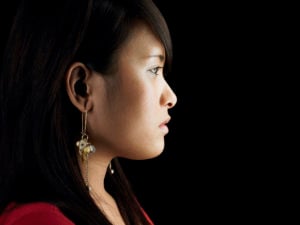Though we’re not always consciously aware of it, our perceptions of those who are dissimilar from us are shaped by a variety of factors.
We are influenced by the environment of our formative years, and we absorb the ideologies of our parents or guardians, teachers, neighbors, friends, and the media.
In many cases, the factors that influence the way we see others are outside of our control.
As a result, if we grow up in an environment where racist, sexist, or otherwise discriminatory ideologies are normalized, it can be hard to detach ourselves from them enough to see how we fit into the perpetuation of these ideologies.
Further, when those ideologies do not seem to be explicitly discriminatory, it becomes even tougher to see how they influence our own interactions with others or how society as a whole is impacted by these ideologies.
One example of this is the way that people of color are frequently underrepresented in film and television.
Recently, due to the Sony hacks, there has been light shed on the entertainment industry as being fully complicit in labeling films “appealing” to people of color as being niche.
While things like this may seem harmless, it is not simply a matter of a few racist jokes gone wrong.
Rather, we have to look behind the screen at the writers, directors, producers, and agents who come together to make decisions about what kinds of movies are released and what kinds of television shows are broadcast.
When people in charge of media corporations have prejudiced beliefs that they believe are harmless, these beliefs are translated to the media that we interact with on a daily basis.
When we are taking in hundreds of media images every day— and the majority of those images present whiteness as better or don’t portray people of color at all — we absorb those messages.
How Racial Bias Affects Us Even When We’re Paying Close Attention
In most cases, we’re not trying to adhere to a hierarchy wherein whiteness is valued above people of color. This hierarchy has already been created and is continued by the information we receive all around us.
Even when we are consciously trying to avoid favoring whiteness, we have a tendency to assign positive characteristics to whites and negative characteristics to non-whites.
One of the most illuminating experiments showing this preference comes from Project Implicit.
The project aims to gather information from volunteers willing to test themselves on their social biases.
Among the tests — which can be taken for free on their website — there is a Race IAT which asks the user to assign negative or positive words to either the African-American group or the European-American group.
According to Project Implicit this test, “indicates that most Americans have a preference for white over black.”
The reason this test is so important and enlightening is that even when I, as a woman of color, went into the test with a conscious understanding of racism and the history of racial preference, I still came out with a result stating that I have a “strong preference for European-Americans over African-Americans.”
The infamous 1940’s Clark Doll Test has long been seen as an illustration of the ways that racial bias begins even in childhood.
The test, re-examined and redone by several professors and media personalities — including Anderson Cooper — aims to prove that even at a young age, children show clear preferences for lighter skin tones.
Through a series of questions regarding the skin-tones of different dolls, including “What color skin would you want to have?” and “What color skin is beautiful,” the test has shown time and time again that kids prefer lighter skin tones, but cannot necessarily explain why.
These results, from both the Race IAT and the Clark Doll Test, can seem innocuous when they appear as a little text bubble on a computer screen, but what is troubling is that even while putting forth our best effort at viewing all races as equal, there are clear biases that we take in when we aren’t paying close attention.
This inability to identify why we may have a preference for one skin tone over another continues even through adulthood.
We don’t stop to ask why we assign positive characteristics to whiteness, even when we are shown that we are doing so against our better judgment.
The Intersection of Microagressions and Macroaggressions
As a society, we have reached a place where identifying and combating racism have become complicated.
People of color experience microaggressions, as well as the effects systemic racism, daily. Both of these can be, and absolutely are, easily downplayed and ignored by whites because their impact is not readily apparent.
An instance in which a person of color is mistaken for a museum worker as opposed to a patron might seem innocent to a white person, but for the person of color, it might represent a microaggression that is frustrating and upsetting.
To a person of color in this instance, the mistake is not an innocent misunderstanding, but rather, a representation of belonging to a group that is assumed to be less-cultured.
Systemic racism is also difficult to pinpoint because it does not always take the form of violence against people of color.
Rather, systemic racism — things such as people of color earning less than whites or the lack of people of color in academia — disproportionately benefits whites in a way that can be ignored unless the power dynamic itself is threatened.
Most recently, the deaths of Michael Brown and Eric Garner have brought issues of systemic racism and its impact on people of color to the forefront of media attention.
Here, there exists tension between people who believe that excessive force on the part of law enforcement more often than not has an element of racism involved and people who argue that race is not a factor in police-citizen interactions.
Both cases are striking because they have shown that when racially motivated events occur, it’s difficult to see the connection between mistreatment and race — especially if you belong to the dominant group that is not usually on the receiving end of the mistreatment.
Ignoring Racial Inequality as a Form of Privilege
Whiteness affords certain people the privilege of ignoring racial disparities because those disparities do not negatively impact them.
Even when white people do acknowledge racial disparities, it’s often framed in the historical, rather than the contemporary.
This is to say that while many white people will acknowledge that racism existed in the past, they fail to see the contemporary impacts of historical injustices.
We tend to reframe the world as it relates to our own individual experiences. As an individual, a white person may not behave in a way that they would define as “racist.”
However, phrases such as “I’m not prejudiced against anyone” or “I see everyone the same way” fail to acknowledge that racism is not the same as prejudice.
While prejudice is the discrimination against someone or a group of someone’s based on an aspect of who they are, racism is a system of advantages stemming from value being placed on a single racial and/or ethnic attribute.
It’s important to note that racism is a system and not just a state of mind. It is a system that impacts individual action, and simultaneously exists and perpetuates itself outside of just individual experiences.
To this point, according to author Beverly Tatum, there are three forms of racism: active racism, anti-racism, and passive racism.
Tatum states:
I sometimes visualize the ongoing cycle of racism as a moving walkway at the airport. Active racist behavior is the equivalent to walking fast on the conveyor belt… Passive racist behavior is equivalent to standing still on the walkway. No overt effort is being made, but the conveyor belt moves the bystanders along to the same destination of as those who are actively walking…unless they are walking actively in the opposite direction at a speed faster than the conveyor belt — unless they are actively anti-racist — they will find themselves carried along with the others.
Active racism is the kind of racism that most people imagine when you use the word “racist.”
The violent acts carried out against people of color, the use of derogatory racial slurs, and preventing people of color from accessing certain spaces are all forms of active racism.
Active racism is easy to identify. There is very little ambiguity in cases of active racism because the violence is often so explicit that it cannot be ignored.
So Then… What Is Anti-Racism?
Anti-racism exists at the opposite end.
It includes actively working against the system of racism by acknowledge how you are privileged by the system and working to dismantle it.
Reading and distributing scholarship and literature by people of color, purposefully showcasing black and brown people in the media, researching the history of racism and its impact on modern society, and demonstrating and protesting against systemic racism are all forms of anti-racism.
Much like in Tatum’s analogy to the moving walkway, anti-racism is incredibly difficult because you are working against a system that is moving in a direction opposite from you.
You are trying to work against a system that has been in place for many years, and you are facing opposition from many people who are benefitting from the system as it currently exists. Most people tend to fall into the category between those two extremes: passive racism.
Within passive racism there exists a spectrum including those who acknowledge that racism still exists, but fail to actively work against the system, all the way to those who do not believe that racism exists anymore, but do not actively participate in discrimination.
Despite where someone falls within this spectrum of passive racism, the fact remains that the walkway still has a forward trajectory.
If you are not moving against the system, even if you are turned the other way, you are still moving in the same direction as those who are actively racist.
This is why complacency is not anti-racism: Because unless you are actively working against the system of racism that impacts society as a whole, you are still benefitting from a system which subjugates people of color and privileges whiteness.
Doing nothing while accepting that a system impacts others negatively does not make a person anti-racist.
Rather, it makes them passively racist in the face of injustice.
This is not only true of race, but of any system of injustice that disproportionally benefits one group over another: men over women, able-bodied individuals over individuals with disabilities, straightness over queerness, etc.
To stand still and allow a system to benefit you while claiming to understand injustices is not anti-anything. It is complacency.
[do_widget id=”text-101″]
Michelle Dominique Burk is a Contributing Writer for Everyday Feminism. Michelle is a recent New York City transplant pursuing her MFA in Creative Writing at Columbia University. She has published articles on Thought Catalog and Esteem Yourself online magazine. In her free time, she enjoys pop culture analysis and contemplating time travel paradoxes.
Search our 3000+ articles!
Read our articles about:
Our online racial justice training
Used by hundreds of universities, non-profits, and businesses.
Click to learn more





















